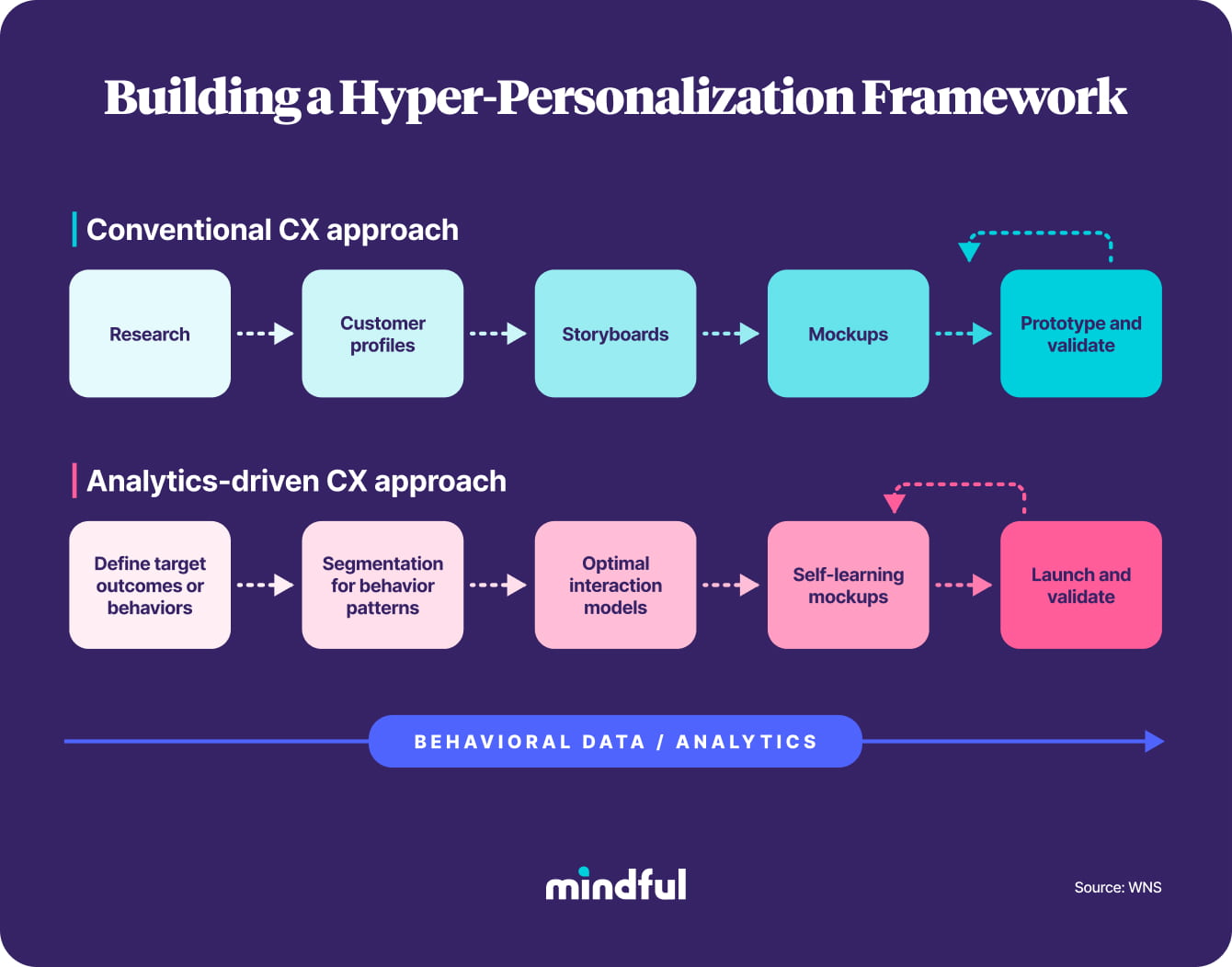With service now the biggest competitive differentiator, it’s no longer enough to provide efficient, or even tailored service. Today’s customers expect an increasing level of personalization and will choose to buy from the brands that are able to tune into their specific needs.
Brands that meet customers in their preferred channel and put the customer in control of their journey—like with the Mindful platform—have a clear leg up over the competition in providing a highly personalized customer experience. And they see the proof in revenue.
As personalized service becomes the norm, brands need to evolve to keep up. And, despite its buzz and trendiness, many in CX roles struggle answering: What is hyper-personalization?
Let’s dig into this context of personalized strategy, contextual data, machine learning, and customer segmentation to understand what customers expect, how brands are showing up, and what you can do to elevate your personalized customer experience.
What is hyper-personalization?
While personalized service often means calling the customer by name and keeping track of preferences, hyper-personalization takes it to a much higher level. It’s now about utilizing customer data to personalize and customize experiences, offers, and content in real time, as Capgemini put it in their white paper.
Today’s customers want to engage with brands that can:
- Instantly identify them.
- Have immediate access to information about every interaction, on every channel.
- Understand their issue and know how to solve it, based on the captured data.
To some, this might sound like an impossible feat. But many brands are approaching their products or services with this level of customer experience personalization already. The technology has been created, the capabilities are there—now it’s a matter of connecting customer data to traditional personalization efforts and personalized service to create uniquely personalized experiences.
Main components of effective customer hyper-personalization
Most brands already have personalized service or customized experiences for customers, and hyper-personalization may not feel like much of an increased step beyond that. But showing up in ways customers expect isn’t just about a highly personalized strategy—it’s about turning it into delightful and impactful experiences.
We see three main ingredients lead to effective hyper-personalization.
Engagement
Many customers expect a basic level of personalization—especially when it comes to digital services. If Netflix and Spotify can use browsing data to create personalized “For You” content, then it’s not a stretch for other brands to do the same.
But where your brand can stand apart in your personalization strategy is how the customer is engaged. Go beyond digital personalization through content and create a personalized experience within your voice channel. Leverage browsing history, purchase history, and customer segmentation to present hyper-personalized offers to customers when they’re on the phone with an agent.
Worried about losing customer data between digital and voice experiences? Offer call scheduling to collect data at the point of transition and equip your agents for a hyper-personalized call.
Relevance
Knowing your customer is half the battle. To create truly personalized experiences to that individual, the content or offer presented needs to be extremely relevant.
Being relevant is a tricky situation if you don’t have the right (or enough) data. In a shortage, you could lean on customer data from similar segments, but don’t rely solely on this, as it can quickly become trite to a customer that identifies themselves outside of that grouping.
The key here is looking at context across channels and experiences. You can’t leverage data just from purchase history alone, for example. Look at how they’ve interacted with you digitally. Identify their goals. And then overlay trends you see in other segments to zero in on something timely and relevant.
Trust
Tracking can be weird—at worst, creepy. Even though a study at the University of Pennsylvania showed that 85% of customers want control over the details marketers can learn about them, 65% resigned themselves to agree that they had no real control.
You definitely don’t want your customers to feel resigned to giving up their data to your brand.
Build trust in these personalized experiences by showing up with empathy. Give customers the option to engage with an agent, and then equip your agents with training to be empathetic listeners and responders.
The more human you can make an interaction, the more customers will focus on being seen (and less on their data being used).
Customer profiling versus hyper-personalizing
While hyper-personalized customer experiences are an emerging trend, many businesses are confusing it with customer profiling. While beneficial in delivering a more relevant experience, profiling is nowhere near as detailed as hyper-personalization.
Profiling can help a business identify customer traits, and even offer service based on these traits, which is a great first step and solid foundation to a personalization strategy.
Where profiling falls short is in the one-to-one: Profiling is far less detailed because it forgoes specific customer history and real-time context.
Only through a hyper-personalized approach can a business identify the oftentimes subtle nuances and details that profiling doesn’t catch to provide highly targeted and personalized products, services, promotions, and content.
To make this happen, hyper-personalizing requires the ability to merge customer interactions with demographic and historical data to paint a clear, contextual picture.
The importance of context in hyper-personalization
As mentioned in making hyper-personalization effective, context is key to relevance and engagement.
And yet for so many brands, context is lost at every transition point across channels.
Think of customers that reach dead ends in self service. They’re searching for an answer to their question, and, when they’re stuck, they search for a phone number and give your contact center a call.
Not only does the customer have to start over, but all the context is lost for the brand. Now the customer is even more frustrated that they’re starting over, the agent has to deal with an unhappy customer, and the brand has no idea where that customer’s session ended, or what’s going to happen after that.
It’s no wonder that context is key to hyper-personalization. The lack of context leaves a customer feeling unseen and insignificant.
Hyper-personalization is dependent on context. Without context around a customer’s history, communication preferences, and up-to-date details of their experience so far, a brand simply cannot deliver a high level of personalization.
Quick tip: If you’re still figuring out how to bridge the gap between your channel experiences, take a look at Mindful—the platform accels at transitioning customers across voice, text, digital, and physical experiences.
Benefits of hyper-personalization
One byproduct of hyper-personalization is also a prerequisite. To deliver extremely customized experiences, you need to have real-time insight into the customer journey—otherwise you don’t know what your customer is seeking in the moment.
Work might need to be scoped to implement tools to achieve real-time insights—but this will benefit both customer experience personalization as well as product development, marketing efforts, and other cross-team efforts in understanding your customers.
Another benefit is obvious: increased revenue. When customers are given offers or experiences unique to them, it’s likely that a solution will surface to their problem. This may take the form of a new product, but it’s also as simple as solving a problem with an existing product—which will build brand loyalty and keep them coming back.
And when they come back, their customer lifetime value is increased (read more on tracking CLV and other metrics). Even though it may be difficult to track this across experiences today, the more you invest in hyper-personalization, the more connected your channels will be, gaining major ground in accurately attributing revenue.
The importance of contact center architecture
To deliver a hyper-personalized customer experience, the right cloud-based technologies are essential. With customers expecting seamless personalized service across a growing number of digital channels, the first step is embracing an omnichannel strategy. This means deploying cloud applications with powerful database management capabilities that offer:
- Contextual relevant data
- Constant, 24-7 availability
- Real-time access
- Global access across teams anywhere in the world
- Scalability
Because customers often use a variety of channels, with sometimes more than one being used at a time, your solutions must be able to support the customer journey wherever it may go., with current context in real time, enabling customer interactions to be adapted and optimized.
Contextual data also needs to be captured and analyzed throughout the entire customer journey, during each interaction, to deliver the hyper-personalized experience that customers expect. With access to “right now” customer data and the ability to map out customer journeys in real time, interactions can be instantly optimized for the customer.
Hyper-personalization framework
After finding business incentives to focus on hyper-personalization, it’s a logical step to implement. But with so many resources required to run hyper-personalization within your organization, it’s wise to pace yourself based on a framework.
We found this effective framework from Monetate’s Personalization Development Study, and it’s really helpful to work your way through three phases into advanced customer experience personalization.
| Source: Monetate | |||
| CHARACTERISTIC | EXPERIMENTING | EMERGING | ADVANCED |
| Staffing | On a list of priority initiatives with a person responsible to report on experiments | Dedicated person to champion usually on the e-commerce team | Personalization has become an integral part of all marketing operations and no longer requires a single dedicated resource. But, instead many people are responsible for personalization including digital marketing, e-commerce and IT |
| Measurement | No ability to measure, or ad hoc process | Ability to measure impact of personalization on digital channels | Structured process to measure ROI from personalization across channels |
| Financial incentives | None | Project-driven | Extended across functions |
| Budget | None | Funded out of overall e-commerce funds | Significant budget dedicated to personalization |
| Data inputs | Use of some batch driven data inputs such as demographic data, used to personalize digital experience | Previous, plus purchase history & real-time website behavioral data | Previous, plus at least three of the following: email activity, mobile actions, POS system and sales associate data |
| Triggered actions | One or two channels, typically email and website | Three or more digital channels | Omnichannel (digital and physical): sales associate, call center, mobile app, website, email, etc. |
| Technology | Manual testing and segmentation | Automated testing and segmentation | Machine learning driven automated analysis and action |
This framework is broken down by area of focus and phases, allowing you to assess for each area what needs to be improved to mature your CX organization.
In another framework from WNS, the path is streamlined and agnostic of area. The path here can be followed by any team to start seeing major growth in personalized experiences.
Source: WNS
The biggest difference here is showcased in how the CX framework begins. An analytics-based approach sets goals up front, where those goals can be mapped to specific outcomes by persona. This creates dedicated paths that anticipate a customer’s needs, as opposed to fitting a customer into a specific path you’ve outlined for them.
The key to this framework is where Mindful excels—putting customers in control of their experience by allowing them to transition seamlessly across channels, and measuring everything along the way to provide context at each stop along the journey.
Why don’t all businesses provide hyper-personalized customer experiences?
Traditional mom and pop retailers have long understood the power of hyper-personalization. As part of a community, business success meant knowing each customer and continuously being closely attuned to customer needs.
In today’s modern, digital marketplace, hyper-personalization requires modern infrastructure that supports both digital and voice channels. Most legacy systems fail to offer this capability, so many businesses have taken to integrating or patching in applications to support this level of service. Often, the results are less than ideal, with siloed channels and missed opportunities.
Challenges of hyper-personalization
Because hyper-personalization is an art and a science, it requires both a strategy and the right technology. The first step is choosing a customer experience platform that breaks down silos and supports omnichannel journeys.
There are also huge limitations with increasingly strict privacy and data protections. Regulations like GDPR are decreasing the amounts of data brands have access to.
This reinforces the need for first-party data—and collecting this type of data is essential at pivotal points between channels. We see huge gaps here where data gets dropped between experiences, leaving the customer with an entirely impersonal interaction.
Utilizing tools that can bridge these gaps and carry first-party context from one interaction to another is key to overcoming challenges in hyper-personalization.
Making the shift to hyper-personalized customer experience
Transitioning to offering hyper-personalized service is never a simple task, even for a business that’s ready to rip and replace legacy infrastructure with new technology that’s primed for real-time data capture and omnichannel journeys.
An important part of making the shift requires an entirely new approach that empowers frontline agents to utilize data in new ways:
- Greater critical thinking—While agent scripts still offer some value, they can’t be relied on as they once were. Businesses can benefit from enabling agents to use data, as well as creativity, empathy, and logic to deliver experiences that are satisfying and memorable to customers.
- More first-call resolutions—Time-strapped customers value their time and have little tolerance for having to repeat their issue. With a hyper-personalized approach, there’s a much greater chance of providing a first-call resolution.
- Data-driven, value-added services—With the additional data and context, agents are in a unique position to proactively offer ancillary services, suggestions, or features that enable customers to gain greater value or satisfaction from their purchase.
- New ways to measure and manage agent performance—Traditional measurements of agent performance may not be relevant with the ability to offer hyper-personalized service. Instead of simply counting the number of calls answered or calculating the duration of each call, measurements, such as how well an agent delivers a relevant customer experience, may be more relevant to overall performance.
Summing up
With the rising number of communication channels and self-service interactions than ever before, customers are increasingly expecting personalization at every point of their journey. The businesses able to offer this level of service will be the ones that will be the next generation of customer service leaders.
This post was originally published in December 2017, and has since been updated.






